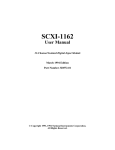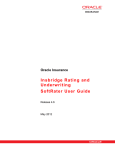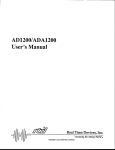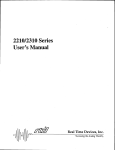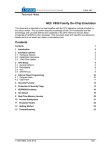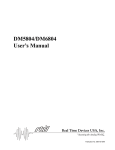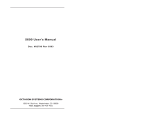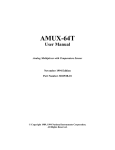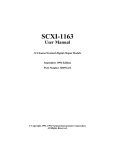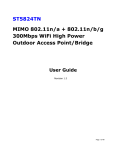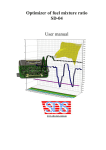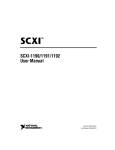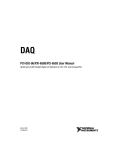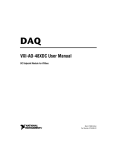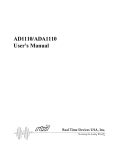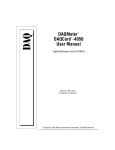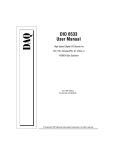Download DAQPad-6507/6508 User Manual
Transcript
DAQPad™-6507/6508 User Manual Digital I/O Devices for USB DAQPad-6507/6508 User Manual December 1998 Edition Part Number 321724B-01 © Copyright 1997, 1998 National Instruments Corporation. All rights reserved. Internet Support E-mail: [email protected] FTP Site: ftp.natinst.com Web Address: http://www.natinst.com Bulletin Board Support BBS United States: 512 794 5422 BBS United Kingdom: 01635 551422 BBS France: 01 48 65 15 59 Fax-on-Demand Support 512 418 1111 Telephone Support (USA) Tel: 512 795 8248 Fax: 512 794 5678 International Offices Australia 03 9879 5166, Austria 0662 45 79 90 0, Belgium 02 757 00 20, Brazil 011 288 3336, Canada (Ontario) 905 785 0085, Canada (Québec) 514 694 8521, Denmark 45 76 26 00, Finland 09 725 725 11, France 01 48 14 24 24, Germany 089 741 31 30, Hong Kong 2645 3186, Israel 03 6120092, Italy 02 413091, Japan 03 5472 2970, Korea 02 596 7456, Mexico 5 520 2635, Netherlands 0348 433466, Norway 32 84 84 00, Singapore 2265886, Spain 91 640 0085, Sweden 08 730 49 70, Switzerland 056 200 51 51, Taiwan 02 377 1200, United Kingdom 01635 523545 National Instruments Corporate Headquarters 6504 Bridge Point Parkway Austin, Texas 78730-5039 USA Tel: 512 794 0100 © Copyright 1997, 1998 National Instruments Corporation. All rights reserved. Important Information Warranty The DAQPad-6507 and DAQPad-6508 are warranted against defects in materials and workmanship for a period of one year from the date of shipment, as evidenced by receipts or other documentation. National Instruments will, at its option, repair or replace equipment that proves to be defective during the warranty period. This warranty includes parts and labor. The media on which you receive National Instruments software are warranted not to fail to execute programming instructions, due to defects in materials and workmanship, for a period of 90 days from date of shipment, as evidenced by receipts or other documentation. National Instruments will, at its option, repair or replace software media that do not execute programming instructions if National Instruments receives notice of such defects during the warranty period. National Instruments does not warrant that the operation of the software shall be uninterrupted or error free. A Return Material Authorization (RMA) number must be obtained from the factory and clearly marked on the outside of the package before any equipment will be accepted for warranty work. National Instruments will pay the shipping costs of returning to the owner parts which are covered by warranty. National Instruments believes that the information in this manual is accurate. The document has been carefully reviewed for technical accuracy. In the event that technical or typographical errors exist, National Instruments reserves the right to make changes to subsequent editions of this document without prior notice to holders of this edition. The reader should consult National Instruments if errors are suspected. In no event shall National Instruments be liable for any damages arising out of or related to this document or the information contained in it. EXCEPT AS SPECIFIED HEREIN, NATIONAL INSTRUMENTS MAKES NO WARRANTIES, EXPRESS OR IMPLIED, AND SPECIFICALLY DISCLAIMS ANY WARRANTY OF MERCHANTABILITY OR FITNESS FOR A PARTICULAR PURPOSE. CUSTOMER’S RIGHT TO RECOVER DAMAGES CAUSED BY FAULT OR NEGLIGENCE ON THE PART OF NATIONAL INSTRUMENTS SHALL BE LIMITED TO THE AMOUNT THERETOFORE PAID BY THE CUSTOMER. NATIONAL INSTRUMENTS WILL NOT BE LIABLE FOR DAMAGES RESULTING FROM LOSS OF DATA, PROFITS, USE OF PRODUCTS, OR INCIDENTAL OR CONSEQUENTIAL DAMAGES, EVEN IF ADVISED OF THE POSSIBILITY THEREOF. This limitation of the liability of National Instruments will apply regardless of the form of action, whether in contract or tort, including negligence. Any action against National Instruments must be brought within one year after the cause of action accrues. National Instruments shall not be liable for any delay in performance due to causes beyond its reasonable control. The warranty provided herein does not cover damages, defects, malfunctions, or service failures caused by owner’s failure to follow the National Instruments installation, operation, or maintenance instructions; owner’s modification of the product; owner’s abuse, misuse, or negligent acts; and power failure or surges, fire, flood, accident, actions of third parties, or other events outside reasonable control. Copyright Under the copyright laws, this publication may not be reproduced or transmitted in any form, electronic or mechanical, including photocopying, recording, storing in an information retrieval system, or translating, in whole or in part, without the prior written consent of National Instruments Corporation. Trademarks ComponentWorks™, CVI™, DAQPad™, LabVIEW™, NI-DAQ™, SCXI™, and VirtualBench™ are trademarks of National Instruments Corporation. Product and company names listed are trademarks or trade names of their respective companies. WARNING REGARDING MEDICAL AND CLINICAL USE OF NATIONAL INSTRUMENTS PRODUCTS National Instruments products are not designed with components and testing intended to ensure a level of reliability suitable for use in treatment and diagnosis of humans. Applications of National Instruments products involving medical or clinical treatment can create a potential for accidental injury caused by product failure, or by errors on the part of the user or application designer. Any use or application of National Instruments products for or involving medical or clinical treatment must be performed by properly trained and qualified medical personnel, and all traditional medical safeguards, equipment, and procedures that are appropriate in the particular situation to prevent serious injury or death should always continue to be used when National Instruments products are being used. National Instruments products are NOT intended to be a substitute for any form of established process, procedure, or equipment used to monitor or safeguard human health and safety in medical or clinical treatment. Contents About This Manual Organization of This Manual ...........................................................................................ix Conventions Used in This Manual...................................................................................x National Instruments Documentation ..............................................................................xi Related Documentation....................................................................................................xii Customer Communication ...............................................................................................xii Chapter 1 Introduction About the DAQPad-6507 and DAQPad-6508 Devices ...................................................1-1 What You Need to Get Started ........................................................................................1-2 Software Programming Choices ......................................................................................1-2 National Instruments Application Software ......................................................1-3 NI-DAQ Driver Software ..................................................................................1-4 Optional Equipment .........................................................................................................1-5 Custom Cabling .................................................................................................1-6 Unpacking ........................................................................................................................1-6 Chapter 2 Installation and Configuration Software Installation ........................................................................................................2-1 Hardware Installation.......................................................................................................2-1 Configuration ...................................................................................................................2-4 Power Considerations ......................................................................................................2-4 Chapter 3 Signal Connections I/O Connector Pin Description ........................................................................................3-2 I/O Connector Signal Connection Descriptions...............................................................3-3 Port C Pin Assignments.....................................................................................3-4 Cable Assembly Connectors ............................................................................................3-4 Digital I/O Signal Connections........................................................................................3-7 Power Connections ..........................................................................................................3-8 Connecting Power Sources to Digital I/O Lines ...............................................3-8 © National Instruments Corporation v DAQPad-6507/6508 User Manual Contents Digital I/O State Selection............................................................................................... 3-9 High DIO State.................................................................................................. 3-9 Low DIO State .................................................................................................. 3-10 Floating DIO State ............................................................................................ 3-11 Timing Specifications...................................................................................................... 3-12 Mode 1 Input Timing ........................................................................................ 3-13 Mode 1 Output Timing ..................................................................................... 3-14 Mode 2 Bidirectional Timing............................................................................ 3-15 Chapter 4 Theory of Operation Interrupt Control Circuitry .............................................................................................. 4-2 USB Microcontroller ....................................................................................................... 4-2 82C55A Programmable Peripheral Interface .................................................................. 4-2 Digital I/O Connector ...................................................................................................... 4-3 Appendix A Specifications Appendix B OKI 82C55A Data Sheet Appendix C Common Questions Appendix D Customer Communication Glossary Index Figures Figure 1-1. The Relationship between the Programming Environment, NI-DAQ, and Your Hardware................................................................. 1-5 Figure 2-1. Connection between Your Computer or USB Hub and Your DAQPad Device ........................................................................... 2-2 DAQPad-6507/6508 User Manual vi © National Instruments Corporation Contents Figure 2-2. Upstream and Downstream Connections between the Host Computer and the DAQPad-6507 or DAQPad-6508 ....................2-4 Figure 3-1. Figure 3-2. Figure 3-3. Figure 3-5. Figure 3-6. Figure 3-7. Screw Terminal Assignments for the DAQPad-6507 .............................3-1 Digital I/O Connector Pin Assignments for the DAQPad-6508 .............3-2 Cable Assembly Connector Pin Assignments for Pins 1 through 50 of the DAQPad-6508 I/O Connector.......................................................3-5 Cable Assembly Connector Pin Assignments for Pins 51 through 100 of the DAQPad-6508 I/O Connector................................................3-6 Digital I/O Connections...........................................................................3-7 DIO Channel Configured for High DIO State with External Load.........3-9 DIO Channel Configured for Low DIO State with External Load .........3-11 Figure 4-1. DAQPad-6507/6508 Devices Block Diagram ........................................4-1 Figure 3-4. Tables Table 2-1. LED Patterns for DAQPad-6507/6508 States .........................................2-3 Table 3-1. Table 3-2. Table 3-3. Pin Assignments for the DAQPad-6508 .................................................3-3 Port C Signal Assignments......................................................................3-4 Timing Signal Descriptions.....................................................................3-12 © National Instruments Corporation vii DAQPad-6507/6508 User Manual About This Manual This manual describes the mechanical and electrical aspects of the DAQPad-6507 and DAQPad-6508 and contains information concerning their operation and programming. The DAQPad-6507 and DAQPad-6508 are digital I/O devices for USB-compatible computers. These devices are designed for high-performance data acquisition and control for applications in laboratory testing, production testing, and industrial process monitoring and control. Organization of This Manual The DAQPad-6507/6508 User Manual is organized as follows: • Chapter 1, Introduction, describes the DAQPad-6507 and DAQPad-6508; lists what you need to get started; describes software programming choices, optional equipment, and custom cables; and explains how to unpack the DAQPad-6507 and DAQPad-6508. • Chapter 2, Installation and Configuration, describes how to install and configure the DAQPad-6507 and DAQPad-6508 devices. • Chapter 3, Signal Connections, includes timing specifications and signal connection instructions for the DAQPad-6507 and 6508 I/O connectors. • Chapter 4, Theory of Operation, contains a functional overview of the DAQPad-6507/6508 devices and explains the operation of each functional unit making up the DAQPad-6507 or DAQPad-6508. • Appendix A, Specifications, lists the specifications of the DAQPad-6507/6508 devices. • Appendix B, OKI 82C55A Data Sheet, contains the manufacturer data sheet for the OKI 82C55A (OKI Semiconductor) CMOS programmable peripheral interface. This interface is used on the DAQPad-6507/6508 devices. • Appendix C, Common Questions, contains a list of commonly asked questions and their answers relating to usage and special features of your DAQPad-6507/6508 devices. © National Instruments Corporation ix DAQPad-6507/6508 User Manual About This Manual • Appendix D, Customer Communication, contains forms you can use to request help from National Instruments or to comment on our products. • The Glossary contains an alphabetical list and description of terms used in this manual, including abbreviations, acronyms, metric prefixes, mnemonics, and symbols. • The Index alphabetically lists the topics in this manual, including the page where you can find each one. Conventions Used in This Manual The following conventions are used in this manual: This icon to the left of bold italicized text denotes a note, which alerts you to important information. ! This icon to the left of bold italicized text denotes a caution, which advises you of precautions to take to avoid injury, data loss, or a system crash. 82C55A 82C55A refers to the OKI 82C55A (OKI Semiconductor) CMOS programmable peripheral interface. <> Angle brackets containing numbers separated by an ellipses represent a range of values associated with a bit or signal name (for example, ACH<0..7>). bold italic Bold italic text denotes a note, caution, or warning. italic Italic text denotes emphasis, a cross reference, or an introduction to a key concept. monospace Text in this font denotes text or characters that you should literally enter from the keyboard, sections of code, programming examples, and syntax examples. This font is also used for the proper names of disk drives, paths, directories, programs, subprograms, subroutines, device names, functions, operations, variables, filenames and extensions, and for statements and comments taken from programs. NI-DAQ NI-DAQ refers to the NI-DAQ software for PC compatibles unless otherwise noted. SCXI SCXI stands for Signal Conditioning eXtensions for Instrumentation and is a National Instruments product line designed to perform front-end signal conditioning for National Instruments plug-in DAQ devices. DAQPad-6507/6508 User Manual x © National Instruments Corporation About This Manual National Instruments Documentation The DAQPad-6507/6508 User Manual is one piece of the documentation set for your data acquisition (DAQ) system. You could have any of several types of manuals, depending on the hardware and software in your system. Use the different types of manuals you have as follows: • Getting Started with SCXI—If you are using SCXI, this is the first manual you should read. It gives an overview of the SCXI system and contains the most commonly needed information for the modules, chassis, and software. • Your SCXI hardware user manuals—If you are using SCXI, read these manuals next for detailed information about signal connections and module configuration. They also explain in greater detail how the module works and contain application hints. • Your DAQ hardware user manuals—These manuals have detailed information about the DAQ hardware that plugs into or is connected to your computer. Use these manuals for hardware installation and configuration instructions, specification information about your DAQ hardware, and application hints. • Software documentation—Examples of software documentation you may have are the LabVIEW, LabWindows/CVI, and NI-DAQ documentation sets. After you set up your hardware system, use either the application software (LabVIEW or LabWindows/CVI) documentation or the NI-DAQ documentation to help you write your application. If you have a large and complicated system, it is worthwhile to look through the software documentation before you configure your hardware. • Accessory installation guides or manuals—If you are using accessory products, read the terminal block and cable assembly installation guides or accessory device user manuals. They explain how to physically connect the relevant pieces of the system. Consult these guides when you are making your connections. • SCXI Chassis User Manual—If you are using SCXI, read this manual for maintenance information on the chassis and installation instructions. © National Instruments Corporation xi DAQPad-6507/6508 User Manual About This Manual Related Documentation If you are a register-level programmer, the following documents contain information that you may find helpful as you read this manual: • Your computer technical reference manual • USB Specification, Revision 1.1 Customer Communication National Instruments wants to receive your comments on our products and manuals. We are interested in the applications you develop with our products, and we want to help if you have problems with them. To make it easy for you to contact us, this manual contains comment and configuration forms for you to complete. These forms are in Appendix D, Customer Communication, at the end of this manual. DAQPad-6507/6508 User Manual xii © National Instruments Corporation Chapter 1 Introduction This chapter describes the DAQPad-6507 and DAQPad-6508; lists what you need to get started; describes software programming choices, optional equipment, and custom cables; and explains how to unpack the DAQPad-6507 and DAQPad-6508. About the DAQPad-6507 and DAQPad-6508 Devices Thank you for purchasing the National Instruments DAQPad-6507 or DAQPad-6508. Your DAQPad device is a 96-bit, parallel, digital I/O interface for computers with USB ports. Four 82C55A programmable peripheral interface (PPI) chips control the 96 bits of digital I/O. The 82C55A can operate in either a unidirectional or bidirectional mode and can generate interrupt requests to the host computer. You can program the 82C55A for almost any 8-bit or 16-bit digital I/O application. All communication is through a standard, 100-pin, female connector for the DAQPad-6508 or 100-screw terminals with a strain-relief clamp for the DAQPad-6507. Your DAQPad device has a wide input voltage range, and can be powered from any 9 to 30 VDC power supply. You can use your DAQPad device in a wide range of digital I/O applications. With the DAQPad-6507 and DAQPad-6508 devices, you can interface any PC to any of the following: • Other computers: – Another PC with a National Instruments PC-DIO-96/PnP, PC-DIO-24/PnP, AT-DIO-32F, DAQPad-6507, or DAQPad-6508 – Any other computer with an 8-bit or 16-bit parallel interface • Centronics-compatible printers and plotters • Panel meters • Instruments and test equipment with BCD readouts and/or controls • Optically isolated, solid-state relays and I/O module mounting racks © National Instruments Corporation 1-1 DAQPad-6507/6508 User Manual Chapter 1 Note Introduction Your DAQPad device cannot sink sufficient current to drive the SSR-OAC-5 and SSR-OAC-5A output modules. However, it can drive the SSR-ODC-5 output module and all SSR input modules available from National Instruments. If you need to drive an SSR-OAC-5 or SSR-OAC-5A, you can either use a non-inverting digital buffer chip between your DAQPad device and the SSR backplane, or you can use an MIO series device with appropriate connections (for example, an SC-205X and cables). With a DAQPad-6507or DAQPad-6508, your computer can serve as a digital I/O system controller for laboratory testing, production testing, and industrial process monitoring and control. Detailed specifications of the DAQPad-6507 and DAQPad-6508 devices are in Appendix A, Specifications. What You Need to Get Started To set up and use your DAQPad-6507 or DAQPad-6508, you will need the following: ❑ DAQPad-6507 or DAQPad-6508 device ❑ DAQPad-6507/6508 User Manual ❑ One of the following software packages and documentation: – NI-DAQ for PC Compatibles – LabVIEW for Windows – LabWindows/CVI – ComponentWorks – VirtualBench ❑ Your computer Software Programming Choices There are several options to choose from when programming your National Instruments DAQ and SCXI hardware. You can use LabVIEW, LabWindows/CVI, ComponentWorks, VirtualBench, NI-DAQ, or register-level programming. DAQPad-6507/6508 User Manual 1-2 © National Instruments Corporation Chapter 1 Introduction National Instruments Application Software LabVIEW and LabWindows/CVI are innovative program development software packages for data acquisition and control applications. LabVIEW uses graphical programming, whereas LabWindows/CVI enhances traditional programming languages. Both packages include extensive libraries for data acquisition, instrument control, data analysis, and graphical data presentation. LabVIEW features interactive graphics, a state-of-the-art user interface, and a powerful graphical programming language. The LabVIEW Data Acquisition VI Library, a series of VIs for using LabVIEW with National Instruments DAQ hardware, is included with LabVIEW. The LabVIEW Data Acquisition VI Library is functionally equivalent to the NI-DAQ software. LabWindows/CVI features interactive graphics, a state-of-the-art user interface, and uses the ANSI standard C programming language. The LabWindows/CVI Data Acquisition Library, a series of functions for using LabWindows/CVI with National Instruments DAQ hardware, is included with the NI-DAQ software kit. The LabWindows/CVI Data Acquisition Library is functionally equivalent to the NI-DAQ software. ComponentWorks contains tools for data acquisition and instrument control built on NI-DAQ driver software. ComponentWorks provides a higher-level programming interface for building virtual instruments through standard OLE controls and DLLs. With ComponentWorks, you can use all of the configuration tools, resource management utilities, and interactive control utilities included with NI-DAQ. VirtualBench features virtual instruments that combine DAQ products, software, and your computer to create a stand-alone instrument with the added benefit of the processing, display, and storage capabilities of your computer. VirtualBench instruments load and save waveform data to disk in the same forms that can be used in popular spreadsheet programs and word processors. Using LabVIEW, LabWindows/CVI, ComponentWorks, or VirtualBench software will greatly reduce the development time for your data acquisition and control application. © National Instruments Corporation 1-3 DAQPad-6507/6508 User Manual Chapter 1 Introduction NI-DAQ Driver Software The NI-DAQ driver software is included at no charge with all National Instruments DAQ hardware. NI-DAQ is not packaged with SCXI or accessory products, except for the SCXI-1200. NI-DAQ has an extensive library of functions that you can call from your application programming environment. These functions include routines for analog input (A/D conversion), buffered data acquisition (high-speed A/D conversion), analog output (D/A conversion), waveform generation, digital I/O, counter/timer operations, SCXI, RTSI, self-calibration, messaging, and acquiring data to extended memory. NI-DAQ has both high-level DAQ I/O functions for maximum ease of use and low-level DAQ I/O functions for maximum flexibility and performance. Examples of high-level functions are streaming data to disk or acquiring a certain number of data points. An example of a low-level function is writing directly to registers on the DAQ device. NI-DAQ does not sacrifice the performance of National Instruments DAQ devices because it lets multiple devices operate at their peak performance. NI-DAQ also internally addresses many of the complex issues between the computer and the DAQ hardware such as programming interrupts and DMA controllers. NI-DAQ maintains a consistent software interface among its different versions so that you can change platforms with minimal modifications to your code. Whether you are using conventional programming languages or NI-DAQ software, your application uses the NI-DAQ driver software, as illustrated in Figure 1-1. DAQPad-6507/6508 User Manual 1-4 © National Instruments Corporation Chapter 1 Conventional Programming Environment Introduction ComponentWorks, LabVIEW, LabWindows/CVI, or VirtualBench NI-DAQ Driver Software DAQ or SCXI Hardware Personal Computer or Workstation Figure 1-1. The Relationship between the Programming Environment, NI-DAQ, and Your Hardware Optional Equipment National Instruments offers a variety of products to use with your DAQPad-6508 device, including cables, connector blocks, and other accessories, as follows: • Cables and cable assemblies • Connector blocks and unshielded 50-pin screw terminals • SCXI modules and accessories for isolating, amplifying, exciting, and multiplexing signals—from up to 3,072 channels—for relays and analog output • Low channel count signal conditioning modules, devices, and accessories, including conditioning for strain gauges and RTDs, simultaneous sample and hold, and relays For more specific information about these products, refer to your National Instruments catalogue or website, or call the office nearest you. © National Instruments Corporation 1-5 DAQPad-6507/6508 User Manual Chapter 1 Introduction Custom Cabling National Instruments offers cables and accessories for you to prototype your application or to use if you frequently change device interconnections. You can connect the DAQPad-6508 device to a wide range of printers, plotters, test instruments, I/O racks and modules, screw terminal panels, and almost any device with a parallel interface. The DAQPad-6508 digital I/O connector is a standard, 100-pin header connector. Adapters for this header connector expand the interface to four 50-pin ribbon cables, each of which has the pinout of a PC-DIO-24. The pin assignments of the expansion cables are compatible with the standard 24-channel I/O module mounting racks (such as those manufactured by Opto 22 and Gordos). The CB-100 cable termination accessory is available from National Instruments for use with your DAQPad device. This accessory includes two 50-conductor, flat-ribbon cables and a connector block. You can attach signal input and output wires to screw terminals on the connector block and, therefore, connect signals to your DAQPad device I/O connector. You can use the CB-100 for initial prototyping of an application or in situations in which your DAQPad device interconnections are frequently changed. When a final field wiring scheme has been developed, you might want to develop your own cable. If you want to develop your own cable, the mating connector for the DAQPad-6508 is a 100-position, right-angle receptacle without board locks. Recommended manufacturer part numbers for this mating connector are as follows: • AMP Corporation (part number 749076-9) • Honda Corporation (part number PCS-XE100LFD-HS) Unpacking Your DAQPad-6507 or DAQPad-6508 device is shipped in an antistatic package to prevent electrostatic damage to the device. Electrostatic discharge can damage several components on the device. To avoid such damage in handling the device, never touch the exposed pins of connectors. DAQPad-6507/6508 User Manual 1-6 © National Instruments Corporation Chapter Installation and Configuration 2 This chapter describes how to install and configure the DAQPad-6507 and DAQPad-6508 devices. Software Installation You should install your software before you install your DAQPad-6507 or DAQPad-6508. If you are using LabVIEW, LabWindows/CVI, ComponentWorks, or VirtualBench, install this software before installing NI-DAQ driver software. Refer to your software release notes for your software for installation instructions. Note The DAQPad-6507/6508 devices require NI-DAQ 6.0 or 6.1 for Windows 95, or NI-DAQ 6.5 or later for Windows 98 (strongly recommended with USB). To ensure that you have the latest version of NI-DAQ, install it from the CD that ships with your device. To install NI-DAQ, refer to your NI-DAQ release notes. Find the installation section for your operating system and follow the instructions given there. Hardware Installation You can connect your DAQPad-6507 or DAQPad-6508 to any available USB socket. The following are general installation instructions, but consult your computer user manual or technical reference manual for specific instructions and warnings. Refer to Figure 2-1 to learn more about making connections for DAQPad-6507/6508 device. The following are general installation instructions, but consult your personal computer user manual or technical reference manual for specific instructions and warnings. Note To ensure proper operation of your DAQPad device, follow the instructions in the sequence shown below. Otherwise, your DAQPad might not initialize properly, and © National Instruments Corporation 2-1 DAQPad-6507/6508 User Manual Chapter 2 Installation and Configuration you will need to turn off the DAQPad rocker switch and restart your DAQPad device again. 1. Connect the USB cable from the computer port or from any hub to the port on your DAQPad device. Refer to Figure 2-1 for more information on connections. Upstream Connector Computer or Hub Downstream Connector DAQPad Figure 2-1. Connection between Your Computer or USB Hub and Your DAQPad Device 2. Flip the rocker switch to turn the power on for the DAQPad-6507 or DAQPad-6508. Your computer should detect your DAQPad device immediately, and when the computer recognizes your DAQPad device, the LED on the front panel blinks or lights up, depending on the status of your device. 3. If the LED comes on after the DAQPad is powered and connected to the host, it is functioning properly. Refer to Table 2-1 for LED pattern descriptions for your DAQPad device. 4. Configure your DAQPad device and any accessories with the NI-DAQ Configuration Utility. When the LED blinks, it turns on and off for one second each for as many times as necessary, then waits three seconds before repeating the cycle. DAQPad-6507/6508 User Manual 2-2 © National Instruments Corporation Chapter 2 Installation and Configuration Table 2-1. LED Patterns for DAQPad-6507/6508 States LED Note DAQPad-6507/6508 State Description Off Off or in the low power, suspend mode Your DAQPad device is turned off or in the low power, suspend mode. 2 blinks Addressed state This pattern is displayed if the host computer detects your DAQPad device but cannot configure it because there are no system resources available. If your DAQPad remains in this state, check your software installation. 3 blinks Power supply failure This pattern is displayed if you try to draw too much power from the USB. You must attach the external power supply. 4 blinks General error state If this pattern is displayed, contact National Instruments. On Configured state Your DAQPad device is configured. The DAQPad-6507/6508 devices use 100 kΩ resistors for polarity selection. These signals are controlled by a switch on the back of your DAQPad. For more information, see the Digital I/O State Selection section in Chapter 3, Signal Connections. © National Instruments Corporation 2-3 DAQPad-6507/6508 User Manual Chapter 2 Installation and Configuration Your DAQPad-6507/6508 device is now installed. Refer to Figure 2-2 to learn more about upstream and downstream connections between the host computer and the DAQPad-6507/6508 devices. Host Computer with Upstream Connector DAQPad-6507/6508 with Downstream Connector Figure 2-2. Upstream and Downstream Connections between the Host Computer and the DAQPad-6507 or DAQPad-6508 Configuration The DAQPad-6507/6508 devices are completely software-configurable, hot Plug and Play instruments. The Plug and Play services query the instrument and allocate the required resources. The operating system enables the instrument for operation. Refer to your software documentation for more information. Power Considerations The DAQPad device remains powered up only when the USB cable connects it to the host computer and the computer is powered up. The host computer has the ability to go into a power-saving suspend mode. During this time, your DAQPad device can also go into a low-power mode, and the I/O signals remain in a fully powered, static state. The advantage of the low-power mode is that it conserves power. This mode is important if you are using a battery pack, even though all of the analog circuitry and digital I/O is powered off and the +5 V supply on the I/O connector is turned off in this state. DAQPad-6507/6508 User Manual 2-4 © National Instruments Corporation Chapter 2 Installation and Configuration When the DAQPad exits the suspend mode, NI-DAQ will reinitialize your DAQPad device and all I/O signals to their default state, regardless of whether your DAQPad device is in low power mode or static mode. This action might change the current I/O states and gain if your DAQPad device is the low powered, static mode. The default behavior of your DAQPad device is to go into powered, static state when the computer enters its suspend mode. In the powered static state of your DAQPad device, you can draw current from the +5 V pin on the connector and all digital I/O lines and analog output channels will be static at a fixed voltage. Note Refer to the Set_DAQ_Device_Info function in the NI-DAQ Function Reference Manual to change the settings that determine the behavior of your DAQPad device during the suspend state. If low-power consumption is a concern, the recommended way to turn off your DAQPad device is with the rocker switch located on the rear panel. This switch turns your DAQPad device on and off by disconnecting both the external power supply and the USB supply. It is also possible to turn off your DAQPad device by detaching the USB cable while leaving the external supply attached; however, several milliamperes are continually drawn from the external supply in this case, although no power is drawn from the USB supply. If you are using a battery pack, such as the BP-1, it is best to use the rocker switch on the back panel to prolong the charge of the battery. © National Instruments Corporation 2-5 DAQPad-6507/6508 User Manual Chapter 3 Signal Connections This chapter includes timing specifications and signal connection instructions for the DAQPad-6507 and DAQPad-6508 I/O connectors. ! Caution Connections that exceed any of the maximum ratings of input or output signals on the DAQPad-6507/6508 devices can damage the device and the computer. The description of each signal in this section includes information about maximum input ratings. National Instruments is not liable for any damages resulting from any inaccurate signal connections. To learn more about screw terminal assignments on the DAQPad-6507, refer to Figure 3-1. APA 0 1 2 0 1 3 BPA 4 5 6 7 3 4 5 6 0 1 2 3 4 0 1 2 3 APB G N D G N D 0 2 2 Vcc Vcc 0 1 3 4 5 6 7 3 4 5 6 0 1 2 3 1 2 3 4 5 6 5 6 7 4 5 6 4 5 6 7 5 6 7 2 3 4 7 0 1 2 3 DPA 7 4 7 DPB 5 6 7 0 1 CPC 0 4 1 CPB 0 7 BPC CPA 2 6 BPB 7 APC 1 5 2 3 DPC 5 6 7 0 1 2 3 4 Figure 3-1. Screw Terminal Assignments for the DAQPad-6507 © National Instruments Corporation 3-1 DAQPad-6507/6508 User Manual Chapter 3 Signal Connections I/O Connector Pin Description Figure 3-2 shows the pin assignments for the DAQPad-6507/6508 digital I/O connector. APC7 BPC7 APC6 BPC6 APC5 BPC5 APC4 BPC4 APC3 BPC3 APC2 BPC2 APC1 BPC1 APC0 BPC0 APB7 BPB7 APB6 BPB6 APB5 BPB5 APB4 BPB4 APB3 BPB3 APB2 BPB2 APB1 BPB1 APB0 BPB0 APA7 BPA7 APA6 BPA6 APA5 BPA5 APA4 BPA4 APA3 BPA3 APA2 BPA2 APA1 BPA1 APA0 BPA0 +5 V GND 1 2 3 4 5 6 7 8 9 10 11 12 13 14 15 16 17 18 19 20 21 22 23 24 25 26 27 28 29 30 31 32 33 34 35 36 37 38 39 40 41 42 43 44 45 46 47 48 49 50 51 52 53 54 55 56 57 58 59 60 61 62 63 64 65 66 67 68 69 70 71 72 73 74 75 76 77 78 79 80 81 82 83 84 85 86 87 88 89 90 91 92 93 94 95 96 97 98 99 100 CPC7 DPC7 CPC6 DPC6 CPC5 DPC5 CPC4 DPC4 CPC3 DPC3 CPC2 DPC2 CPC1 DPC1 CPC0 DPC0 CPB7 DPB7 CPB6 DPB6 CPB5 DPB5 CPB4 DPB4 CPB3 DPB3 CPB2 DPB2 CPB1 DPB1 CPB0 DPB0 CPA7 DPA7 CPA6 DPA6 CPA5 DPA5 CPA4 DPA4 CPA3 DPA3 CPA2 DPA2 CPA1 DPA1 CPA0 DPA0 +5 V GND Figure 3-2. Digital I/O Connector Pin Assignments for the DAQPad-6508 DAQPad-6507/6508 User Manual 3-2 © National Instruments Corporation Chapter 3 Signal Connections I/O Connector Signal Connection Descriptions Refer to Table 3-1 for pin assignments for the DAQPad-6508. Table 3-1. Pin Assignments for the DAQPad-6508 Pin Signal Name Description 1, 3, 5, 7, 9, 11, 13, 15 APC<7..0> Bidirectional Data Lines for Port C of PPI A—APC7 is the MSB, APC0 the LSB. 17, 19, 21, 23, 25, 27, 29, 31 APB<7..0> Bidirectional Data Lines for Port B of PPI A—APB7 is the MSB, APB0 the LSB. 33, 35, 37, 39, 41, 43, 45, 47 APA<7..0> Bidirectional Data Lines for Port A of PPI A—APA7 is the MSB, APA0 the LSB. 2, 4, 6, 8, 10, 12, 14, 16 BPC<7..0> Bidirectional Data Lines for Port C of PPI B—BPC7 is the MSB, BPC0 the LSB. 18, 20, 22, 24, 26, 28, 30, 32 BPB<7..0> Bidirectional Data Lines for Port B of PPI B—BPB7 is the MSB, BPB0 the LSB. 34, 36, 38, 40, 42, 44, 46, 48 BPA<7..0> Bidirectional Data Lines for Port A of PPI B—BPA7 is the MSB, BPA0 the LSB. 51, 53, 55, 57, 59, 61, 63, 65 CPC<7..0> Bidirectional Data Lines for Port C of PPI C—CPC7 is the MSB, CPC0 the LSB. 67, 69, 71, 73, 75, 77, 79, 81 CPB<7..0> Bidirectional Data Lines for Port B of PPI C—CPB7 is the MSB, CPB0 the LSB. 83, 85, 87, 89, 91, 93, 95, 97 CPA<7..0> Bidirectional Data Lines for Port A of PPI C—CPA7 is the MSB, CPA0 the LSB. 52, 54, 56, 58, 60, 62, 64, 66 DPC<7..0> Bidirectional Data Lines for Port C of PPI D—DPC7 is the MSB, DPC0 the LSB. 68, 70, 72, 74, 76, 78, 80, 82 DPB<7..0> Bidirectional Data Lines for Port B of PPI D—DPB7 is the MSB, DPB0 the LSB. 84, 86, 88, 90, 92, 94, 96, 98 DPA<7..0> Bidirectional Data Lines for Port A of PPI D—DPA7 is the MSB, DPA0 the LSB. 49, 99 +5 V +5 V—These pins are connected to the DAQPad’s +5 VDC supply. 50, 100 GND Ground—These pins are connected to the computer’s ground signal. Note: Pins 49 and 99 are connected to the +5 V PC power supply via a 1 A self-resetting fuse. © National Instruments Corporation 3-3 DAQPad-6507/6508 User Manual Chapter 3 Signal Connections Port C Pin Assignments The signals assigned to port C depend on the mode in which the 82C55A is programmed in your application software. In mode 0, port C is considered as two 4-bit I/O ports. In modes 1 and 2, port C is used for status and handshaking signals with zero, two, or three lines available for general-purpose input/output. Table 3-2 summarizes the signal assignments of port C for each programmable mode. ! Caution During programming, be aware that each time a port is configured, output ports A and C are reset to 0, and output port B is undefined. Table 3-2. Port C Signal Assignments Programming Mode Group A PC7 PC6 Group B PC5 PC4 PC3 PC2 PC1 PC0 Mode 0 I/O I/O I/O I/O I/O I/O I/O I/O Mode 1 Input I/O I/O IBFA STBA* INTRA STBB* IBFBB INTRB Mode 1 Output OBFA* ACKA* I/O I/O INTRA ACKB* OBFB* INTRB Mode 2 OBFA* ACKA* IBFA STBA* INTRA I/O I/O I/O * Indicates that the signal is active low; refer to Table 3-3 for signal name definitions. Cable Assembly Connectors The cable assembly referred to in the Optional Equipment section in Chapter 1, Introduction, is an assembly of two 50-pin cables and three connectors. Both cables are joined to a single connector on one end and to individual connectors on the free ends. The 100-pin connector that joins the two cables plugs into the I/O connector of the DAQPad-6508. The other two connectors are 50-pin connectors, one of which is connected to pins 1 through 50, and the other is connected to pins 51 through 100 of the DAQPad-6508 I/O connector. The cables are labelled Position 1-50 and 51-100, respectively. Figures 3-3 and 3-4 show the pin assignments for the 50-pin connectors on the cable assembly. DAQPad-6507/6508 User Manual 3-4 © National Instruments Corporation Chapter 3 APC7 1 2 BPC7 APC6 3 4 BPC6 APC5 5 6 BPC5 APC4 7 8 BPC4 APC3 9 10 BPC3 APC2 11 12 BPC2 APC1 13 14 BPC1 APC0 15 16 BPC0 APB7 17 18 BPB7 APB6 19 20 BPB6 APB5 21 22 BPB5 APB4 23 24 BPB4 APB3 25 26 BPB3 APB2 27 28 BPB2 APB1 29 30 BPB1 APB0 31 32 BPB0 APA7 33 34 BPA7 APA6 35 36 BPA6 APA5 37 38 BPA5 APA4 39 40 BPA4 APA3 41 42 BPA3 APA2 43 44 BPA2 APA1 45 46 BPA1 APA0 47 48 BPA0 +5 V 49 50 GND Signal Connections Figure 3-3. Cable Assembly Connector Pin Assignments for Pins 1 through 50 of the DAQPad-6508 I/O Connector © National Instruments Corporation 3-5 DAQPad-6507/6508 User Manual Chapter 3 Signal Connections CPC7 1 2 DPC7 CPC6 3 4 DPC6 CPC5 5 6 DPC5 CPC4 7 8 DPC4 CPC3 9 10 DPC3 CPC2 11 12 DPC2 CPC1 13 14 DPC1 CPC0 15 16 DPC0 CPB7 17 18 DPB7 CPB6 19 20 DPB6 CPB5 21 22 DPB5 CPB4 23 24 DPB4 CPB3 25 26 DPB3 CPB2 27 28 DPB2 CPB1 29 30 DPB1 CPB0 31 32 DPB0 CPA7 33 34 DPA7 CPA6 35 36 DPA6 CPA5 37 38 DPA5 CPA4 39 40 DPA4 CPA3 41 42 DPA3 CPA2 43 44 DPA2 CPA1 45 46 DPA1 CPA0 47 48 DPA0 +5 V 49 50 GND Figure 3-4. Cable Assembly Connector Pin Assignments for Pins 51 through 100 of the DAQPad-6508 I/O Connector DAQPad-6507/6508 User Manual 3-6 © National Instruments Corporation Chapter 3 Signal Connections Digital I/O Signal Connections Pins 1 through 48 and pins 51 through 98 of the I/O connector are digital I/O signal pins. Figure 3-5 depicts signal connections for three typical digital I/O applications. +5 V +5 V LED Front Switch 100 kΩ 100 kΩ 100 kΩ 100 kΩ 41 PPI A Port A APA<3..0> 43 45 47 100 kΩ 100 kΩ 100 kΩ 100 kΩ 67 69 TTL Signal PPI C Port B CPB<7..4> 71 73 +5 V Switch * 50, 100 GND I/O Connector DAQPad-6507/6508 * Complex switch circuitry is not shown in order to simplify the figure. Figure 3-5. Digital I/O Connections In Figure 3-5, PPI A, port A is configured for digital output, and PPI C, port B is configured for digital input. Digital input applications include receiving TTL signals and sensing external device states, such as the state of the switch in Figure 3-5. Digital output applications include sending TTL signals and driving external devices such as the LED shown in Figure 3-5. © National Instruments Corporation 3-7 DAQPad-6507/6508 User Manual Chapter 3 Signal Connections Power Connections Two pins on the I/0 connector supply +5 V from your DAQPad device’s power supply through a self-resetting fuse. The fuse resets automatically within a few seconds after the overcurrent condition is removed. These two pins are referenced to DGND and can be used to power external digital circuitry.The power rating is indicated below. Power rating: +4.65 VDC to +5.25 VDC at 1 A combined total for both pins ! Caution Never connect the +5 V power pins (pins 49 and 99) directly to analog or digital ground or to any other voltage source on your DAQPad device or any other device. Doing so can damage your DAQPad device and the computer. National Instruments is not liable for damages resulting from such a connection. Pins 49 and 99 of the I/O connector are connected to the +5 V supply of the DAQPad-6507/6508 devices. You can power the DAQPad-6507 or DAQPad-6508 from either USB power or an external source. The DAQPad uses USB power when the external source is not plugged in. USB power limits any device from using more than 0.5 A. If you are running from USB power (that is, if your external power source is not plugged in), you have only 150 mA to drive signals and supply power for your circuitry. If you require more power than 150 mA, attach the external power source. Also, your host computer might turn off power to your DAQPad device if no activity is detected. This cuts the power to any external circuitry powered by your DAQPad device if you are not using an external power source. Refer to Power Considerations, in Chapter 2, Installation and Configuration, of this manual. Connecting Power Sources to Digital I/O Lines ! Caution Always turn your DAQPad on before applying external power to the digital I/O (DIO) lines. If your DAQPad is off and external power is applied to the DIO lines, your DAQPad may be damaged. National Instruments is not liable for damage caused by incorrect power sequencing. When supplying power to DIO lines, we strongly recommend you use the +5 V source from the DAQPad. If you must use an external power source, it is important to sequence the power correctly—DAQPad first, then external power—to prevent damage to the CMOS circuits. Because of a trait common to all CMOS circuits, applying external power first may cause current to flow incorrectly, damaging the circuit. DAQPad-6507/6508 User Manual 3-8 © National Instruments Corporation Chapter 3 Signal Connections Digital I/O State Selection You can power up the digital I/O lines for the DAQPad-6507/6508 devices in a user-defined state. The DAQPad-6507/6508 devices facilitate user-configurable pull-up or pull-down tasks. Each DIO channel is connected to a 100 kΩ resistor and can be pulled high or low using the front panel switch. You can use this switch to pull all 96 DIO lines high or low, or you can allow the lines to float. However, if all lines are high, you might want to pull some lines low. To do this properly, you must understand the nature of the drive current on those lines and adhere to TTL logic levels, or you can let the lines float and tie them all high or low as necessary. High DIO State If you select the pulled-high mode, each DIO line will be pulled to VCC (+5 VDC) with a 100 kΩ resistor. To pull a specific line low, connect between that line and ground and use a pull-down resistor (RL) whose value will give you a maximum of 0.4 VDC. The DIO lines provide a maximum of 2.5 mA at 3.7 V in the high state. Use the largest possible resistor so that you do not use more current than necessary to perform the pull-down task. Also, make sure the resistor value is not so large that leakage current from the DIO line along with the current from the 100 kΩ pull-up resistor drives the voltage at the resistor above a TTL low level of 0.4 VDC. DAQPad-6507/6508 +5 V 100 kΩ 82C55A Digital I/O Line RL GND Figure 3-6. DIO Channel Configured for High DIO State with External Load © National Instruments Corporation 3-9 DAQPad-6507/6508 User Manual Chapter 3 Signal Connections Example: At power up, the device is configured for input and, by default, all DIO lines are high. To pull one channel low, follow these steps: 1. Install a load (RL). Remember that the smaller the resistance, the greater the current consumption and the lower the voltage (V). 2. Using the following formula, calculate the largest possible load to maintain a logic low level of 0.4 V and supply the maximum driving current (I). V = I * RL ⇒ RL = V / I, where: V= 0.4 V is the voltage across RL I = 46 µA + 10 µA is the 4.6 V across the 100 kΩ pull-up resistor and 10 µA from 82C55 leakage current Therefore: RL = 7.1 kΩ is the 0.4 V / 56 µA This resistor value, 7.1 kΩ, provides a maximum of 0.4 V on the DIO line at power up. You can substitute smaller resistor values, but they will draw more current, leaving less drive current for other circuitry connected to this line. The 7.1 kΩ resistor reduces the amount of a logic high source current by 0.4 mA with a 2.8 V output. Low DIO State If you select pulled-low mode, each DIO line will be pulled to GND (0 VDC) using a 100 kΩ resistor. If you want to pull a specific line high, connect a pull-up resistor that gives you a minimum of 2.8 VDC. The DIO lines are capable of sinking a maximum of 2.5 mA at 0.4 V in the low state. Use the largest possible resistance value so that you do not use more current than necessary to perform the pull-up task. Also, make sure the pull-up resistor value is not so large that leakage current from the DIO line along with the current from the 100 kΩ pull-down resistor brings the voltage at the resistor below a TTL-high level of 2.8 VDC. DAQPad-6507/6508 User Manual 3-10 © National Instruments Corporation Chapter 3 DAQPad-6507/6508 Signal Connections +5 V RL 82C55A Digital I/O Line 100 kΩ GND Figure 3-7. DIO Channel Configured for Low DIO State with External Load Example: The switch is set in the low DIO state, which means all DIO lines are pulled low. If you want to pull one channel high, follow these steps: 1. Install a load (RL). Remember that the smaller the resistance, the greater the current consumption and the lower the voltage (V). 2. Using the following formula, calculate the largest possible load to maintain a logic high level of 2.8 V and supply the maximum sink current (I). V = I * RL ⇒ RL = V / I, where: V = 2.2 V is the voltage across RL I = 28 µA + 10 µA is the 2.8 V across the 100 kΩ pull-up resistor and 10 µA from 82C55A leakage current Therefore: RL = 5.7 kΩ is the 2.2 V / 38 µA This resistor value, 5.7 kΩ, provides a minimum of 2.8 V on the DIO line at power up. You can substitute smaller resistor values but they draw more current, leaving less sink current for other circuitry connected to this line. The 5.7 kΩ resistor reduces the amount of a logic low sink current by 0.8 mA with a 0.4 V output. Floating DIO State The DIO lines are not pulled high or low by your DAQPad device in this configuration. Use an external 100 kΩ resistor to pull the line to the state you want. © National Instruments Corporation 3-11 DAQPad-6507/6508 User Manual Chapter 3 Signal Connections Timing Specifications This section lists the timing specifications for handshaking with the DAQPad-6507/6508 devices. The handshaking lines STB* and IBF synchronize input transfers. The handshaking lines OBF* and ACK* synchronize output transfers. The signals in Table 3-3 are used in the timing diagrams later in this chapter. Table 3-3. Timing Signal Descriptions Name Type Description STB* Input Strobe Input—A low signal on this handshaking line loads data into the input latch. IBF Output Input Buffer Full—A high signal on this handshaking line indicates that data has been loaded into the input latch. This is an input acknowledge signal. ACK* Input Acknowledge Input—A low signal on this handshaking line indicates that the data written to the port has been accepted. This signal is a response from the external device indicating that it has received the data from the DAQPad-6507/6508 devices. OBF* Output Output Buffer Full—A low signal on this handshaking line indicates that data has been written to the port. INTR Output Interrupt Request—This signal becomes high when the 82C55A requests service during a data transfer. The appropriate interrupt enable bits must be set to generate this signal. RD* Internal Read Signal—This signal is the read signal generated from the control lines of the computer I/O expansion bus. WR* Internal Write Signal—This signal is the write signal generated from the control lines of the computer I/O expansion bus. DATA Bidirectional Data Lines at the Specified Port—This signal indicates the availability of data on the data lines at a port that is in the output mode. If the port is in the input mode, this signal indicates when the data on the data lines should be valid. DAQPad-6507/6508 User Manual 3-12 © National Instruments Corporation Chapter 3 Signal Connections Mode 1 Input Timing The following figure illustrates the timing specifications for an input transfer in mode 1. T1 T2 T4 STB * T7 IBF T6 INTR RD * T3 T5 DATA Name Description Minimum Maximum T1 STB* pulse width 100 — T2 STB* = 0 to IBF = 1 — 150 T3 Data before STB* = 1 20 — T4 STB* = 1 to INTR = 1 — 150 T5 Data after STB* = 1 50 — T6 RD* = 0 to INTR = 0 — 200 T7 RD* = 1 to IBF = 0 — 150 All timing values are in nanoseconds. © National Instruments Corporation 3-13 DAQPad-6507/6508 User Manual Chapter 3 Signal Connections Mode 1 Output Timing The following figure illustrates the timing specifications for an output transfer in mode 1. T3 WR* T4 OBF* T1 T6 INTR T5 ACK* DATA T2 Name Description Minimum Maximum T1 WR* = 0 to INTR = 0 — 250 T2 WR* = 1 to output — 200 T3 WR* = 1 to OBF* = 0 — 150 T4 ACK* = 0 to OBF* = 1 — 150 T5 ACK* pulse width 100 — T6 ACK* = 1 to INTR = 1 — 150 All timing values are in nanoseconds. DAQPad-6507/6508 User Manual 3-14 © National Instruments Corporation Chapter 3 Signal Connections Mode 2 Bidirectional Timing The following figure illustrates the timing specifications for bidirectional transfers in mode 2. T1 WR * T6 OBF * INTR T7 ACK * T3 STB * T10 T4 IBF RD * T2 T5 T8 T9 DATA Name Description Minimum Maximum T1 WR* = 1 to OBF* = 0 — 150 T2 Data before STB* = 1 20 — T3 STB* pulse width 100 — T4 STB* = 0 to IBF = 1 — 150 T5 Data after STB* = 1 50 — T6 ACK* = 0 to OBF = 1 — 150 T7 ACK* pulse width 100 — T8 ACK* = 0 to output — 150 T9 ACK* = 1 to output float 20 250 T10 RD* = 1 to IBF = 0 — 150 All timing values are in nanoseconds. © National Instruments Corporation 3-15 DAQPad-6507/6508 User Manual Chapter 4 Theory of Operation This chapter contains a functional overview of the DAQPad-6507/6508 devices and explains the operation of each functional unit making up the DAQPad-6507 or DAQPad-6508. The block diagram in Figure 4-1 illustrates the key functional components of the DAQPad-6507/6508 devices. External Power 5 V Supply Power Supply Controls Power Supply Switch +5 V 500 mA Address/Data USB Interface Serial Configuration EEPROM Control Lines 6 82C55 PPI (A) 3 Data 2 Interrupt Request Power Supply Controls USB Microcontroller Intel 8x930AX Serial Port Interface 8 Port B 8 Port C 8 Port A 8 Address/Data Serial EEPROM Configuration Port Port A Interrupt Controls FPGA Bus Interface Wait State Controls Address/Data Bus Control Lines 6 82C55 PPI (B) 82C55 PPI (C) Control Lines 6 Address/Data Address/Data Firmware EEPROM 8 Port C 8 Port A 8 Control Lines 6 Address/Data Port B 82C55 PPI (D) Port B 8 Port C 8 Port A 8 Port B 8 Port C 8 Terminal Blocks (100 POS) Power Supply Controls SRAM Address/Data 82C53 Timer Figure 4-1. DAQPad-6507/6508 Devices Block Diagram © National Instruments Corporation 4-1 DAQPad-6507/6508 User Manual Chapter 4 Theory of Operation Interrupt Control Circuitry Interrupt control circuitry enables and disables interrupts. Two software-controlled registers determine which devices, if any, generate interrupts in the interrupt circuitry of the DAQPad-6507/6508 devices. Each of the four 82C55A devices has two interrupt lines, PC3 and PC0, connected to the interrupt circuitry. Each of the eight interrupt lines can interrupt the host computer if the interrupt circuitry is enabled and the corresponding enable bit is set. Normally, PC3 and/or PC0 of the 82C55A devices are controlled by the handshaking circuitry; however, you can configure and use either of these two lines for input and external interrupts. An interrupt occurs on the low-to-high transition of the signal line. Refer to Appendix B, OKI 82C55A Data Sheet for more information. USB Microcontroller The USB controller is a special microcontroller that has circuitry necessary to transmit and receive data over USB itself. It maintains information about the status of the bus and follows the USB protocol to acquire and send information over the bus. The microcontroller receives instruction codes over USB, parses the instructions, and executes them. NI-DAQ handles all interaction with the microcontroller. 82C55A Programmable Peripheral Interface The four 82C55A PPI chips are the heart of the DAQPad-6507/6508 devices. Each of these chips has 24 programmable I/O pins that represent three 8-bit ports: PA, PB, and PC. Each port can be programmed as an input or an output port. The 82C55A has three modes of operation: simple I/O (mode 0), strobed I/O (mode 1), and bidirectional I/O (mode 2). In modes 1 and 2, the three ports are divided into two groups: group A and group B. Each group has eight data bits and four control and status bits from port C (PC). Modes 1 and 2 use handshaking signals from port C to synchronize data transfers. Refer to Appendix B, OKI 82C55A Data Sheet, for more detailed information. DAQPad-6507/6508 User Manual 4-2 © National Instruments Corporation Chapter 4 Theory of Operation Digital I/O Connector All digital I/O is transmitted through a standard, 100-pin, female connector for the DAQPad-6508 or 100-pin screw terminal with a strain-relief clamp for the DAQPad-6507. Pins 49 and 99 are connected to +5 V through a self-restarting protection fuse (F1). See Figure 4-1 for its location. This +5 V supply is often required to operate I/O module mounting racks. Pins 50 and 100 are connected to ground. See the Optional Equipment section in Chapter 1, Introduction, as well as Chapter 2, Installation and Configuration, and the Digital I/O Signal Connections section in Chapter 3, Signal Connections, for additional information. © National Instruments Corporation 4-3 DAQPad-6507/6508 User Manual Appendix A Specifications This appendix lists the specifications of the DAQPad-6507/6508 devices. These specifications are typical at 25° C, unless otherwise stated. The operating temperature range is 0° to 70° C. Digital I/O Number of channels ............................... 96 I/O Compatibility ......................................... TTL Absolute max voltage rating .................. –0.5 to +5.5 V with respect to GND Handshaking........................................... Requires 1 port Power-on state........................................ Configured as inputs, high (selectable on the front panel switch) Data transfers ......................................... Interrupts, programmed I/O Digital logic levels Level Min Max Input low voltage –0.3 V 0.8 V Input high voltage 2.2 V 5.3 V Input low current (Vin= 0.8 V) — –1.0 µA Input high current (Vin= 2.4 V) — 1.0 µA Output low voltage (Iout = 2.5 mA) 0V 0.4 V Output high voltage (Iout= -2.5 mA) 3.7 V 5.0 V –1.0 µA 1.0 µA Input current (0 < Vin < 5 V) © National Instruments Corporation A-1 DAQPad-6507/6508 User Manual Appendix A Specifications Output signals Pin 49 and pin 99 (at +5 V) .............0.5 A max Note The total combined current output from pins 49 and 99 may be limited by the available current from the USB. If you do not have the external power supply connected, you have only 150 mA of current available to drive all outputs, including DIO lines. Transfer rates ..........................................Up to 60 S/s Power Requirement External 9 to 30 VDC.....................................12 W max USB 4.40 to 5.25 VDC.............................220 mA typ, 500 mA max Physical Dimensions .............................................22.9 by 14.6 cm (9.0 by 5.7 in.) I/O connector DAQPad-6507 .................................100-screw terminals DAQPad-6508 .................................100-pin female, 0.050 series D-type Environment Operating temperature ............................0° to 70° C Storage temperature ................................–55° to 150° C Relative humidity ...................................5% to 90% noncondensing DAQPad-6507/6508 User Manual A-2 © National Instruments Corporation Appendix OKI 82C55A Data Sheet B This appendix contains the manufacturer data sheet for the OKI 82C55A1 (OKI Semiconductor) CMOS programmable peripheral interface. This interface is used on the DAQPad-6507/6508 devices. 1 Copyright © OKI Semiconductor 1993. Reprinted with permission of copyright owner. All rights reserved. OKI Semiconductor Data Book Microprocessor, Seventh Edition, March 1993 © National Instruments Corporation B-1 DAQPad-6507/6508 User Manual Appendix B OKI 82C55A Data Sheet DAQPad-6507/6508 User Manual B-2 © National Instruments Corporation Appendix B © National Instruments Corporation B-3 OKI 82C55A Data Sheet DAQPad-6507/6508 User Manual Appendix B OKI 82C55A Data Sheet DAQPad-6507/6508 User Manual B-4 © National Instruments Corporation Appendix B © National Instruments Corporation B-5 OKI 82C55A Data Sheet DAQPad-6507/6508 User Manual Appendix B OKI 82C55A Data Sheet DAQPad-6507/6508 User Manual B-6 © National Instruments Corporation Appendix B © National Instruments Corporation B-7 OKI 82C55A Data Sheet DAQPad-6507/6508 User Manual Appendix B OKI 82C55A Data Sheet DAQPad-6507/6508 User Manual B-8 © National Instruments Corporation Appendix B © National Instruments Corporation B-9 OKI 82C55A Data Sheet DAQPad-6507/6508 User Manual Appendix B OKI 82C55A Data Sheet DAQPad-6507/6508 User Manual B-10 © National Instruments Corporation Appendix B © National Instruments Corporation B-11 OKI 82C55A Data Sheet DAQPad-6507/6508 User Manual Appendix B OKI 82C55A Data Sheet DAQPad-6507/6508 User Manual B-12 © National Instruments Corporation Appendix B © National Instruments Corporation B-13 OKI 82C55A Data Sheet DAQPad-6507/6508 User Manual Appendix B OKI 82C55A Data Sheet DAQPad-6507/6508 User Manual B-14 © National Instruments Corporation Appendix B © National Instruments Corporation B-15 OKI 82C55A Data Sheet DAQPad-6507/6508 User Manual Appendix B OKI 82C55A Data Sheet DAQPad-6507/6508 User Manual B-16 © National Instruments Corporation Appendix B © National Instruments Corporation B-17 OKI 82C55A Data Sheet DAQPad-6507/6508 User Manual Appendix C Common Questions This appendix contains a list of commonly asked questions and their answers relating to usage and special features of your DAQPad-6507/6508 devices. General Information What are DAQPad-6507/6508 devices? The DAQPad-6507/6508 devices are USB platform, 96-line DIO devices. What type of 5 V protection do the DAQPad-6507/6508 devices have? The DAQPad-6507/6508 devices have 5 V lines equipped with a self-resetting 1 A fuse. Installation and Configuration How do I know if my version of Windows supports USB? Look in the System properties in the control panel. The Device Manager tab should list a Universal Serial Bus Controller along with a USB Controller and a USB root hub. If your computer has this and also USB ports, your machine is supported. If your computer has USB ports but no controller is listed in the Device Manager, you might need to upgrade your software. What is the best way to test my device without having to program the device? If you are using Windows, the NI-DAQ Configuration Utility has a Test menu with some excellent tools for doing simple functional tests of the device, such as analog input and output, digital I/O, and counter/timer tests. © National Instruments Corporation C-1 DAQPad-6507/6508 User Manual Appendix C Common Questions What does the blink pattern mean for the configuration LED on the front panel? This LED blinks to indicate the status of the DAQPad-6507/6508 devices. It also can indicate an error through a blink code. Refer to Table 2-1 for more information. Digital I/O What are the power-on states of the PPI and DIO lines on the I/O connector? At system power-on and reset, both the PPI and DIO lines are set to high impedance by the hardware. This means that the device circuitry is not actively driving the output either high or low. However, these lines may have pull-up or pull-down resistors connected to them as shown in the Digital I/O State Selection section in Chapter 3, Signal Connections. These resistors weakly pull the output to either a logic high or logic low state. DAQPad-6507/6508 User Manual C-2 © National Instruments Corporation Appendix Customer Communication D For your convenience, this appendix contains forms to help you gather the information necessary to help us solve your technical problems and a form you can use to comment on the product documentation. When you contact us, we need the information on the Technical Support Form and the configuration form, if your manual contains one, about your system configuration to answer your questions as quickly as possible. National Instruments has technical assistance through electronic, fax, and telephone systems to quickly provide the information you need. Our electronic services include a bulletin board service, an FTP site, a fax-on-demand system, and e-mail support. If you have a hardware or software problem, first try the electronic support systems. If the information available on these systems does not answer your questions, we offer fax and telephone support through our technical support centers, which are staffed by applications engineers. Electronic Services Bulletin Board Support National Instruments has BBS and FTP sites dedicated for 24-hour support with a collection of files and documents to answer most common customer questions. From these sites, you can also download the latest instrument drivers, updates, and example programs. For recorded instructions on how to use the bulletin board and FTP services and for BBS automated information, call 512 795 6990. You can access these services at: United States: 512 794 5422 Up to 14,400 baud, 8 data bits, 1 stop bit, no parity United Kingdom: 01635 551422 Up to 9,600 baud, 8 data bits, 1 stop bit, no parity France: 01 48 65 15 59 Up to 9,600 baud, 8 data bits, 1 stop bit, no parity FTP Support To access our FTP site, log on to our Internet host, ftp.natinst.com, as anonymous and use your Internet address, such as [email protected], as your password. The support files and documents are located in the /support directories. © National Instruments Corporation D-1 DAQPad-6507/6508 User Manual Fax-on-Demand Support Fax-on-Demand is a 24-hour information retrieval system containing a library of documents on a wide range of technical information. You can access Fax-on-Demand from a touch-tone telephone at 512 418 1111. E-Mail Support (Currently USA Only) You can submit technical support questions to the applications engineering team through e-mail at the Internet address listed below. Remember to include your name, address, and phone number so we can contact you with solutions and suggestions. [email protected] Telephone and Fax Support National Instruments has branch offices all over the world. Use the list below to find the technical support number for your country. If there is no National Instruments office in your country, contact the source from which you purchased your software to obtain support. Country Telephone Fax Australia Austria Belgium Brazil Canada (Ontario) Canada (Québec) Denmark Finland France Germany Hong Kong Israel Italy Japan Korea Mexico Netherlands Norway Singapore Spain Sweden Switzerland Taiwan United Kingdom United States 03 9879 5166 0662 45 79 90 0 02 757 00 20 011 288 3336 905 785 0085 514 694 8521 45 76 26 00 09 725 725 11 01 48 14 24 24 089 741 31 30 2645 3186 03 6120092 02 413091 03 5472 2970 02 596 7456 5 520 2635 0348 433466 32 84 84 00 2265886 91 640 0085 08 730 49 70 056 200 51 51 02 377 1200 01635 523545 512 795 8248 03 9879 6277 0662 45 79 90 19 02 757 03 11 011 288 8528 905 785 0086 514 694 4399 45 76 26 02 09 725 725 55 01 48 14 24 14 089 714 60 35 2686 8505 03 6120095 02 41309215 03 5472 2977 02 596 7455 5 520 3282 0348 430673 32 84 86 00 2265887 91 640 0533 08 730 43 70 056 200 51 55 02 737 4644 01635 523154 512 794 5678 DAQPad-6507/6508 User Manual D-2 © National Instruments Corporation Technical Support Form Photocopy this form and update it each time you make changes to your software or hardware, and use the completed copy of this form as a reference for your current configuration. Completing this form accurately before contacting National Instruments for technical support helps our applications engineers answer your questions more efficiently. If you are using any National Instruments hardware or software products related to this problem, include the configuration forms from their user manuals. Include additional pages if necessary. Name __________________________________________________________________________ Company _______________________________________________________________________ Address ________________________________________________________________________ _______________________________________________________________________________ Fax ( ___ ) ________________Phone ( ___ ) __________________________________________ Computer brand____________ Model ___________________ Processor_____________________ Operating system (include version number) ____________________________________________ Clock speed ______MHz RAM _____MB Mouse ___yes ___no Display adapter __________________________ Other adapters installed _______________________________________ Hard disk capacity _____MB Brand_________________________________________________ Instruments used _________________________________________________________________ _______________________________________________________________________________ National Instruments hardware product model _____________ Revision ____________________ Configuration ___________________________________________________________________ National Instruments software product ___________________ Version _____________________ Configuration ___________________________________________________________________ The problem is: __________________________________________________________________ _______________________________________________________________________________ _______________________________________________________________________________ _______________________________________________________________________________ _______________________________________________________________________________ List any error messages: ___________________________________________________________ _______________________________________________________________________________ _______________________________________________________________________________ The following steps reproduce the problem: ___________________________________________ _______________________________________________________________________________ _______________________________________________________________________________ _______________________________________________________________________________ _______________________________________________________________________________ DAQPad-6507/6508 Hardware and Software Configuration Form Record the settings and revisions of your hardware and software on the line to the right of each item. Complete a new copy of this form each time you revise your software or hardware configuration, and use this form as a reference for your current configuration. Completing this form accurately before contacting National Instruments for technical support helps our applications engineers answer your questions more efficiently. National Instruments Products DAQ hardware __________________________________________________________________ Interrupt level of hardware _________________________________________________________ Base I/O address of hardware _______________________________________________________ Programming choice _____________________________________________________________ NI-DAQ, LabVIEW, or LabWindows/CVI version ______________________________________ Other boards in system ____________________________________________________________ Base I/O address of other boards ____________________________________________________ DMA channels of other boards _____________________________________________________ Interrupt level of other boards ______________________________________________________ Other Products Computer make and model ________________________________________________________ Microprocessor __________________________________________________________________ Clock frequency or speed __________________________________________________________ Type of video board installed _______________________________________________________ Operating system version __________________________________________________________ Operating system mode ___________________________________________________________ Programming language ___________________________________________________________ Programming language version _____________________________________________________ Other boards in system ____________________________________________________________ Base I/O address of other boards ____________________________________________________ DMA channels of other boards _____________________________________________________ Interrupt level of other boards ______________________________________________________ Documentation Comment Form National Instruments encourages you to comment on the documentation supplied with our products. This information helps us provide quality products to meet your needs. Title: DAQPad ™-6507/6508 User Manual Edition Date: December 1998 Part Number: 321724B-01 Please comment on the completeness, clarity, and organization of the manual. _______________________________________________________________________________ _______________________________________________________________________________ _______________________________________________________________________________ _______________________________________________________________________________ _______________________________________________________________________________ _______________________________________________________________________________ _______________________________________________________________________________ If you find errors in the manual, please record the page numbers and describe the errors. _______________________________________________________________________________ _______________________________________________________________________________ _______________________________________________________________________________ _______________________________________________________________________________ _______________________________________________________________________________ _______________________________________________________________________________ _______________________________________________________________________________ Thank you for your help. Name _________________________________________________________________________ Title __________________________________________________________________________ Company _______________________________________________________________________ Address ________________________________________________________________________ _______________________________________________________________________________ E-Mail Address __________________________________________________________________ Phone ( ___ ) __________________________ Fax ( ___ ) _______________________________ Mail to: Technical Publications National Instruments Corporation 6504 Bridge Point Parkway Austin, Texas 78730-5039 Fax to: Technical Publications National Instruments Corporation 512 794 5678 Glossary Prefix Meanings Value p- pico- 10 –12 n- nano- 10 – 9 µ- micro- 10 – 6 m- milli- 10 – 3 k- kilo- 10 3 M- mega- 10 6 G- giga- 10 9 Symbols/Numbers % percent ± plus or minus ° degrees / per + positive of, or plus – negative of, or minus Ω ohms square root of +5 V +5 VDC source signal © National Instruments Corporation G-1 DAQPad-6507/6508 User Manual Glossary A A amperes AC alternating current AC coupled allowing the transmission of AC signals while blocking DC signals ACH analog input channel signal ACK* acknowledge input signal A/D analog-to-digital address character code that identifies a specific location (or series of locations) in memory AIRQ0 PPI A interrupt request bit for Port A AIRQ1 PPI A interrupt request bit for POrt B alias a false lower frequency component that appears in sampled data acquired at too low a sampling rate ALU arithmetic logic unit—the element(s) in a processing system that perform(s) the mathematical functions such as addition, subtraction, multiplication, division, inversion, AND, OR, NAND, and NOR AMD Advanced Micro Devices ANSI American National Standards Institute APA bidirectional data lines for Port A of PPI A APB bidirectional data lines for Port B of PPI A APC bidirectional data lines for Port C of PPI A ASIC application-specific integrated circuit asynchronous (1) hardware—a property of an event that occurs at an arbitrary time, without synchronization to a reference clock (2) software—a property of a function that begins an operation and returns prior to the completion or termination of the operation DAQPad-6507/6508 User Manual G-2 © National Instruments Corporation Glossary B b bit—one binary digit, either 0 or 1 B byte—eight related bits of data, an eight-bit binary number. Also used to denote the amount of memory required to store one byte of data. bandwidth the range of frequencies present in a signal, or the range of frequencies to which a measuring device can respond base address a memory address that serves as the starting address for programmable registers. All other addresses are located by adding to the base address. baud rate serial communications data transmission rate expressed in bits per second (b/s) BCD binary-coded decimal binary a number system with a base of 2 BIOS basic input/output system or built-in operating system bipolar a signal range that includes both positive and negative values (for example, –5 V to +5 V) BIRQ0 PPI B interrupt request bit for Port A BIRQ1 PPI B interrupt request bit for Port B BNC a type of coaxial signal connector BPA bidirectional data lines for Port A of PPI B BPB bidirectional data lines for Port B of PPI B BPC bidirectional data lines for Port C of PPI B break-before-make a type of switching contact that is completely disengaged from one terminal before it connects with another terminal breakdown voltage the voltage high enough to cause breakdown of optical isolation, semiconductors, or dielectric materials. See also working voltage. buffer temporary storage for acquired or generated data (software) © National Instruments Corporation G-3 DAQPad-6507/6508 User Manual Glossary burst-mode a high-speed data transfer in which the address of the data is sent followed by back-to-back data words while a physical signal is asserted bus the group of conductors that interconnect individual circuitry in a computer. Typically, a bus is the expansion vehicle to which I/O or other devices are connected. Examples of PC buses are the AT bus, NuBus, Micro Channel, and EISA bus. bus master a type of a plug-in board or controller with the ability to read and write devices on the computer bus C C Celsius channel pin or wire lead to which you apply or from which you read the analog or digital signal. Analog signals can be single-ended or differential. For digital signals, you group channels to form ports. Ports usually consist of either four or eight digital channels. channel clock the clock controlling the time interval between individual channel sampling within a scan. Boards with simultaneous sampling do not have this clock. chromatograph an instrument used in chemical analysis of gases and liquids. CI computing index circuit trigger a condition for starting or stopping clocks CIRQ0 PPI C interrupt request bit for Port A CIRQ1 PPI C interrupt request bit for Port B clock hardware component that controls timing for reading from or writing to groups CMOS complementary metal-oxide semiconductor coupling the manner in which a signal is connected from one location to another CPA bidirectional lines for Port A of PPI C CPB bidirectional lines for Port A of PPI C DAQPad-6507/6508 User Manual G-4 © National Instruments Corporation Glossary CPC bidirectional lines for Port A of PPIC CPU central processing unit crosstalk an unwanted signal on one channel due to an input on a different channel CTR1 counter 1 enable bit CTRIRQ counter interrupt enable bit current drive capability the amount of current a digital or analog output channel is capable of sourcing or sinking while still operating within voltage range specifications current sinking the ability of a DAQ board to dissipate current for analog or digital output signals current sourcing the ability of a DAQ board to supply current for analog or digital output signals D DAC digital-to-analog converter—an electronic device, often an integrated circuit, that converts a digital number into a corresponding analog voltage or current daisy-chain a method of propagating signals along a bus, in which the devices are prioritized on the basis of their position on the bus DAQ data acquisition—(1) collecting and measuring electrical signals from sensors, transducers, and test probes or fixtures and inputting them to a computer for processing; (2) collecting and measuring the same kinds of electrical signals with A/D and/or DIO boards plugged into a computer, and possibly generating control signals with D/A and/or DIO boards in the same computer DATA data lines at the specified port signal DC direct current DC coupled allowing the transmission of both AC and DC signals © National Instruments Corporation G-5 DAQPad-6507/6508 User Manual Glossary DCS distributed control system—a large-scale process control system characterized by a distributed network of processors and I/O subsystems that encompass control, user interfacing, data collection, and system management. DCSs are commonly used in large industrial facilities, such as a petroleum refinery or paper mill. default setting a default parameter value recorded in the driver. In many cases, the default input of a control is a certain value (often 0) that means use the current default setting. For example, the default input for a parameter may be do not change current setting, and the default setting may be no AMUX-64T boards. If you do change the value of such a parameter, the new value becomes the new setting. You can set default settings for some parameters in the configuration utility or manually using switches located on the device. device a plug-in DAQ board, card, or pad that can contain multiple channels and conversion devices. Plug-in boards, PCMCIA cards, and devices such as the DAQPad-1200, which connects to your computer parallel port, are all examples of DAQ devices. SCXI modules are distinct from devices, with the exception of the SCXI-1200, which is a hybrid. DGND digital ground signal digital port See port. digital trigger a TTL level signal having two discrete levels—a high and a low level DIN Deutsche Industrie Norme DIO digital input/output DIP dual inline package DIRQ0 PPI D interrupt request bit for Port A DIRQ1 PPI D interrupt request bit for Port B DMA direct memory access DNL differential nonlinearity DOS disk operating system downstream the direction of data flow from the host computer or away from the host DAQPad-6507/6508 User Manual G-6 © National Instruments Corporation Glossary DPA bidirectional data lines for Port A of PPI D DPB bidirectional data lines for Port B of PPI D DPC bidirectional data lines for Port C of PPI D DRAM dynamic RAM drivers software that controls a specific hardware device such as a DAQ board or a GPIB interface board DSP digital signal processing dual-access memory memory that can be sequentially accessed by more than one controller or processor but not simultaneously accessed. Also known as shared memory. dual-ported memory memory that can be simultaneously accessed by more than one controller or processor dynamic range the ratio of the largest signal level a circuit can handle to the smallest signal level it can handle (usually taken to be the noise level), normally expressed in decibels E ECL emitter-coupled logic EEPROM electrically erasable programmable read-only memory EGA enhanced graphics adapter EISA Extended Industry Standard Architecture EMC electromechanical compliance EPROM erasable programmable read-only memory—ROM that can be erased (usually by ultraviolet light exposure) and reprogrammed event the condition or state of an analog or digital signal expansion ROM an onboard EEPROM that may contain device-specific initialization and system boot functionality external trigger a voltage pulse from an external source that triggers an event such as A/D conversion © National Instruments Corporation G-7 DAQPad-6507/6508 User Manual Glossary F false triggering triggering that occurs at an unintended time fetch-and-deposit a data transfer in which the data bytes are transferred from the source to the controller, and then from the controller to the target FIFO first-in-first-out floating signal sources signal sources with voltage signals that are not connected to an absolute reference or system ground. Also called nonreferenced signal sources. Some common example of floating signal sources are batteries, transformers, or thermocouples. flyby a type of high-performance data transfer in which the data bytes pass directly from the source to the target without being transferred to the controller ft feet G GND ground GPIB General Purpose Interface bus, synonymous with HP-IB. The standard bus used for controlling electronic instruments with a computer. Also called IEEE 488 bus because it is defined by ANSI/IEEE Standards 488-1978, 488.1-1987, and 488.2-1987. grms level of random vibration ground tie point the location where two or more grounds (such as digital ground, analog output ground, analog input ground, and so on), are connected or tied together grounded measurement system See referenced single-ended measurement system. DAQPad-6507/6508 User Manual G-8 © National Instruments Corporation Glossary H h hour half-power bandwidth the frequency range over which a circuit maintains a level of at least –3 dB with respect to the maximum level handle pointer to a pointer to a block of memory; handles reference arrays and strings. An array of strings is a handle to a block of memory containing handles to strings. handler a device driver that is installed as part of the operating system of the computer handshaked digital I/O a type of digital acquisition/generation where a device or module accepts or transfers data after a digital pulse has been received. Also called latched digital I/O. hardware the physical components of a computer system, such as the circuit boards, plug-in boards, chassis, enclosures, peripherals, cables, and so on hardware triggering a form of triggering where you set the start time of an acquisition and gather data at a known position in time relative to a trigger signal hex hexadecimal host the host computer system where the Universal Serial Bus host controller is installed Hz hertz I IBF input buffer full signal IBFA input buffer bit for Port A IBFB input buffer bit for Port B IBM International Business Machines IC integrated circuit ID identification © National Instruments Corporation G-9 DAQPad-6507/6508 User Manual Glossary IDE integrated development environment IEEE Institute of Electrical and Electronics Engineers IEEE 488 the shortened notation for ANSI/IEEE Standards 488-1978, 488.1-1987, and 488.2-1987. See also GPIB. immediate digital I/O a type of digital acquisition/generation where LabVIEW updates the digital lines or port states immediately or returns the digital value of an input line. Also called nonlatched digital I/O. in. inches Industrial Device Networks standardized digital communications networks used in industrial automation applications; they often replace vendor-proprietary networks so that devices from different vendors can communicate in control systems INL integral nonlinearity—a measure in LSB of the worst-case deviation from the ideal A/D or D/A transfer characteristic of the analog I/O circuitry input bias current the current that flows into the inputs of a circuit input impedance the measured resistance and capacitance between the input terminals of a circuit input offset current the difference in the input bias currents of the two inputs of an instrumentation amplifier instrument driver a set of high-level software functions that controls a specific GPIB, VXI, or RS-232 programmable instrument or a specific plug-in DAQ board. Instrument drivers are available in several forms, ranging from a function callable language to a virtual instrument (VI) in LabVIEW. instrumentation amplifier a circuit whose output voltage with respect to ground is proportional to the difference between the voltages at its two inputs INTE1 interrupt enable bit for Port A output interrupts INTE2 interrupt enable bit for Port A input interrupts INTEA interrupt enable bit for Port A INTEB interrupt enable bit for Port B integral control a control action that eliminates the offset inherent in proportional control DAQPad-6507/6508 User Manual G-10 © National Instruments Corporation Glossary INTEN global interrupt enable bit interrupt a computer signal indicating that the CPU should suspend its current task to service a designated activity interrupt level the relative priority at which a device can interrupt interval scanning scanning method where there is a longer interval between scans than there is between individual channels comprising a scan INTR interrupt request signal INTRA interrupt request status bit for Port A INTRB interrupt request status bit for Port B I/O input/output IOH current, output high IOL current, output low IRQ interrupt request ISA Industry Standard Architecture isolation a type of signal conditioning in which you isolate the transducer signals from the computer for safety purposes. This protects you and your computer from large voltage spikes and makes sure the measurements from the DAQ device are not affected by differences in ground potentials. isolation voltage the voltage that an isolated circuit can normally withstand, usually specified from input to input and/or from any input to the amplifier output, or to the computer bus isothermal constructed to maintain constant temperature across area. Isothermal construction of terminal blocks increases thermocouple measurement accuracy. © National Instruments Corporation G-11 DAQPad-6507/6508 User Manual Glossary K k kilo—the standard metric prefix for 1,000, or 103, used with units of measure such as volts, hertz, and meters K kilo—the prefix for 1,024, or 210, used with B in quantifying data or computer memory kbytes/s a unit for data transfer that means 1,000 or 103 bytes/s kS 1,000 samples Kword 1,024 words of memory L LabVIEW laboratory virtual instrument engineering workbench latched digital I/O a type of digital acquisition/generation where a device or module accepts or transfers data after a digital pulse has been received. Also called handshaked digital I/O. LED light-emitting diode library a file containing compiled object modules, each comprised of one of more functions, that can be linked to other object modules that make use of these functions. NIDAQMSC.LIB is a library that contains NI-DAQ functions. The NI-DAQ function set is broken down into object modules so that only the object modules that are relevant to your application are linked in, while those object modules that are not relevant are not linked. listener a device on the GPIB that receives information from a Talker on the bus LSB least significant bit M m meters M (1) Mega, the standard metric prefix for 1 million or 106, when used with units of measure such as volts and hertz; (2) mega, the prefix for 1,048,576, or 220, when used with B to quantify data or computer memory DAQPad-6507/6508 User Manual G-12 © National Instruments Corporation Glossary MB megabytes of memory MBLT eight-byte block transfers in which both the Address bus and the Data bus are used to transfer data Mbytes/s a unit for data transfer that means 1 million or 10 6 bytes/s memory buffer See buffer. MFLOPS million floating-point operations per second—the unit for expressing the computational power of a processor MIO multifunction I/O MIPS million instructions per second—the unit for expressing the speed of processor machine code instructions MITE MXI Interfaces to Everything is a custom ASIC designed by National Instruments that implements the PCI bus interface. The MITE supports bus mastering for high speed data transfers over the PCI bus. MS million samples MSB most significant bit MTBF mean time between failure multiplexed mode an SCXI operating mode in which analog input channels are multiplexed into one module output so that your cabled DAQ device has access to the module’s multiplexed output as well as the outputs on all other multiplexed modules in the chassis through the SCXI bus. Also called serial mode. mux multiplexer—a switching device with multiple inputs that sequentially connects each of its inputs to its output, typically at high speeds, in order to measure several signals with a single analog input channel N NB NuBus—a slot-dependent, 32-bit bus type used in Macintosh computers that has 32 interrupts NC normally closed, or not connected NI-DAQ National Instruments driver software for DAQ hardware © National Instruments Corporation G-13 DAQPad-6507/6508 User Manual Glossary NIST National Institute of Standards and Technology nodes execution elements of a block diagram consisting of functions, structures, and subVIs noise an undesirable electrical signal—Noise comes from external sources such as the AC power line, motors, generators, transformers, fluorescent lights, soldering irons, CRT displays, computers, electrical storms, welders, radio transmitters, and internal sources such as semiconductors, resistors, and capacitors. Noise corrupts signals you are trying to send or receive. nonlatched digital I/O a type of digital acquisition/generation where LabVIEW and NI-DAQ updates the digital lines or port states immediately or returns the digital value of an input line. Also called immediate digital I/O or non-handshaking. nonreferenced signal sources signal sources with voltage signals that are not connected to an absolute reference or system ground. Also called floating signal sources. Some common examples of nonreferenced signal sources are batteries, transformers, or thermocouples. O OBF* output buffer full signal OBFA* output buffer bit for Port A OBFB* output buffer bit for Port B onboard channels channels provided by the plug-in data acquisition board onboard RAM optional RAM usually installed into SIMM slots OpenDoc a compound document architecture created by the joining of several technologies supplied by Apple (the base OpenDoc architecture, the Bento file system and the Open Scripting Architecture) and IBM (the System Object Model) operating system base-level software that controls a computer, runs programs, interacts with users, and communicates with installed hardware or peripheral devices optical coupler a device designed to transfer electrical signals by utilizing light waves DAQPad-6507/6508 User Manual G-14 © National Instruments Corporation Glossary optical isolation the technique of using an optoelectric transmitter and receiver to transfer data without electrical continuity, to eliminate high-potential differences and transient signals optocoupler to provide coupling with electrical isolation between input and output. Sometimes called optoisolator or photocoupler. OUT output output settling time the amount of time required for the analog output voltage to reach its final value within specified limits output slew rate the maximum rate of change of analog output voltage from one level to another P packet a bundle of data organized in a group for transmission parallel mode a type of SCXI operating mode in which the module sends each of its input channels directly to a separate analog input channel of the device to the module passband the range of frequencies which a device can properly propagate or measure pattern generation a type of handshaked (latched) digital I/O in which internal counters generate the handshaked signal, which in turn initiates a digital transfer. Because counters output digital pulses at a constant rate, this means you can generate and retrieve patterns at a constant rate because the handshaked signal is produced at a constant rate. PC personal computer PC Card a credit-card-sized expansion card that fits in a PCMCIA slot, often referred to as a PCMCIA card PCI Peripheral Component Interconnect—a high-performance expansion bus architecture originally developed by Intel to replace ISA and EISA. It is achieving widespread acceptance as a standard for PCs and workstations; it offers a theoretical maximum transfer rate of 132 Mbytes/s. © National Instruments Corporation G-15 DAQPad-6507/6508 User Manual Glossary PCMCIA an expansion bus architecture that has found widespread acceptance as a de facto standard in notebook-size computers. It originated as a specification for add-on memory cards written by the Personal Computer Memory Card International Association. PFI Programmable Function Input photoelectric sensor an electrical device that responds to a change in the intensity of the light falling upon it pipeline a high-performance processor structure in which the completion of an instruction is broken into its elements so that several elements can be processed simultaneously from different instructions PLC programmable logic controller—a highly reliable special-purpose computer used in industrial monitoring and control applications. PLCs typically have proprietary programming and networking protocols, and special-purpose digital and analog I/O ports. Plug and Play devices devices that do not require DIP switches or jumpers to configure resources on the devices—also called switchless devices Plug and Play ISA a specification prepared by Microsoft, Intel, and other PC-related companies that will result in PCs with plug-in boards that can be fully configured in software, without jumpers or switches on the boards PnP Plug and Play port (1) a communications connection on a computer or a remote controller (2) a digital port, consisting of four or eight lines of digital input and/or output posttriggering the technique used on a DAQ board to acquire a programmed number of samples after trigger conditions are met potentiometer an electrical device the resistance of which can be manually adjusted; used for manual adjustment of electrical circuits and as a transducer for linear or rotary position PPI programmable peripheral interface ppm parts per million pretriggering the technique used on a DAQ board to keep a continuous buffer filled with data, so that when the trigger conditions are met, the sample includes the data leading up to the trigger condition DAQPad-6507/6508 User Manual G-16 © National Instruments Corporation Glossary propagation the transmission of a signal through a computer system propagation delay the amount of time required for a signal to pass through a circuit protocol the exact sequence of bits, characters, and control codes used to transfer data between computers and peripherals through a communications channel, such as the GPIB bus pts points pulsed output a form of counter signal generation by which a pulse is outputted when a counter reaches a certain value Q QuickTime Apple system software tools that make video presentation a standard part of the Macintosh. Applications can use QuickTime to record and display audio and video in the same way applications use system tools to generate and display text and graphics. R RAM random-access memory RD* read signal real time a property of an event or system in which data is processed as it is acquired instead of being accumulated and processed at a later time referenced signal sources signal sources with voltage signals that are referenced to a system ground, such as the earth or a building ground. Also called grounded signal sources. resource locking a technique whereby a device is signaled not to use its local memory while the memory is in use from the bus retry an acknowledge by a destination that signifies that the cycle did not complete and should be repeated REXT external resistance ribbon cable a flat cable in which the conductors are side by side © National Instruments Corporation G-17 DAQPad-6507/6508 User Manual Glossary rise time the difference in time between the 10% and 90% points of a system’s step response RL load resistance rms root mean square RTD resistive temperature device S s seconds S samples sample counter the clock that counts the output of the channel clock, in other words, the number of samples taken. On boards with simultaneous sampling, this counter counts the output of the scan clock and hence the number of scans. SCADA supervisory control and data acquisition—a common PC function in process control applications, where programmable logic controllers (PLCs) perform control functions but are monitored and supervised by a PC scan one or more analog or digital input samples. Typically, the number of input samples in a scan is equal to the number of channels in the input group. For example, one pulse from the scan clock produces one scan which acquires one new sample from every analog input channel in the group. SCANCLK scan clock signal scan clock the clock controlling the time interval between scans. On boards with interval scanning support (for example, the AT-MIO-16F-5), this clock gates the channel clock on and off. On boards with simultaneous sampling (for example, the EISA-A2000), this clock clocks the track-and-hold circuitry. scan rate the number of scans per second. For example, a scan rate of 10 Hz means sampling each channel 10 times per second. SCXI Signal Conditioning eXtensions for Instrumentation SE single-ended inputs shared memory See dual-access memory DAQPad-6507/6508 User Manual G-18 © National Instruments Corporation Glossary signal conditioning the manipulation of signals to prepare them for digitizing signal divider performing frequency division on an external signal SIMM single in-line memory module SISOURCE SI counter clock signal SMB a type of miniature coaxial signal connector software trigger a programmed event that triggers an event such as data acquisition software triggering a method of triggering in which you simulate an analog trigger using software. Also called conditional retrieval. source impedance a parameter of signal sources that reflects current-driving ability of voltage sources (lower is better) and the voltage-driving ability of current sources (higher is better) SOURCE input pin an counter input pin where the counter counts the signal transitions SPDT single-pole double throw—a property of a switch in which one terminal can be connected to one of two other terminals SS simultaneous sampling—a property of a system in which each input or output channel is digitized or updated at the same instant S/s samples per second—used to express the rate at which a DAQ board samples an analog signal STARTSCAN start scan signal STB strobe input signal STC system timing controller statically configured device a device whose logical address cannot be set through software; that is, it is not dynamically configurable switchless device devices that do not require dip switches or jumpers to configure resources on the devices—also called Plug and Play devices synchronous (1) hardware—a property of an event that is synchronized to a reference clock (2) software—a property of a function that begins an operation and returns only when the operation is complete © National Instruments Corporation G-19 DAQPad-6507/6508 User Manual Glossary system RAM RAM installed on a personal computer and used by the operating system, as contrasted with onboard RAM system noise a measure of the amount of noise seen by an analog circuit or an ADC when the analog inputs are grounded T TC terminal count T/H track-and-hold—a circuit that tracks an analog voltage and holds the value on command Theorem signal contains no frequency components higher than half the frequency at which it is sampled, then the original signal can be recovered without distortion throughput rate the data, measured in bytes/s, for a given continuous operation, calculated to include software overhead. Throughput Rate = Transfer Rate Software Overhead Factor. top-level VI VI at the top of the VI hierarchy. This term is used to distinguish the VI from its subVIs. transfer rate the rate, measured in bytes/s, at which data is moved from source to destination after software initialization and set up operations; the maximum rate at which the hardware can operate TRIG trigger signal trigger any event that causes or starts some form of data capture TTL transistor-transistor logic U UART universal asynchronous receiver/transmitter—an integrated circuit that converts parallel data to serial data (and vice versa), commonly used as a computer bus to serial device interface for serial communication UI update interval UISOURCE update interval counter clock signal DAQPad-6507/6508 User Manual G-20 © National Instruments Corporation Glossary unipolar a signal range that is always positive (for example, 0 to +10 V) update the output equivalent of a scan. One or more analog or digital output samples. Typically, the number of output samples in an update is equal to the number of channels in the output group. For example, one pulse from the update clock produces one update which sends one new sample to every analog output channel in the group. UPDATE update signal update rate the number of output updates per second upstream the direction data flow towards the host computer USB Universal Serial Bus V V volts VCC +5 V power supply VDC volts direct current VDMAD virtual DMA driver VEXT external volt VI virtual instrument—(1) a combination of hardware and/or software elements, typically used with a PC, that has the functionality of a classic stand-alone instrument (2) a LabVIEW software module (VI), which consists of a front panel user interface and a block diagram program VIH volts, input high VIL volts, input low VIN volts in VISA a new driver software architecture developed by National Instruments to unify instrumentation software for GPIB, DAQ, and VXI. It has been accepted as a standard for VXI by the VXIplug&play Systems Alliance. © National Instruments Corporation G-21 DAQPad-6507/6508 User Manual Glossary visual basic custom control (VBXs) a specific form of binary packaged object that can be created by different companies and integrated into applications written using Visual Basic VOH volts, output high VOL volts, output low W wire data path between nodes word the standard number of bits that a processor or memory manipulates at one time. Microprocessors typically use 8-, 16-, or 32-bit words. working voltage the highest voltage that should be applied to a product in normal use, normally well under the breakdown voltage for safety margin. See also breakdown voltage. WR* write signal Z zero-overhead looping the ability of a high-performance processor to repeat instructions without requiring time to branch to the beginning of the instructions zero-wait-state memory memory fast enough that the processor does not have to wait during any reads and writes to the memory DAQPad-6507/6508 User Manual G-22 © National Instruments Corporation Index Numbers configuration. See also installation. common questions, C-1 to C-2 Plug and Play capability, 2-4 connecting power to digital I/O lines, 3-8 connectors. See cable assembly connectors; I/O connector pin descriptions. CPA<7..0> signal (table), 3-3 CPB<7..0> signal (table), 3-3 CPC<7..0> signal (table), 3-3 custom cabling, 1-6 customer communication, xii, D-1 to D-2 +5 V signal (table), 3-3 82C55A Programmable Peripheral Interface OKI 82C55A data sheet, B-1 to B-17 overview, 4-2 A ACK* signal description (table), 3-12 mode 1 output timing (figure), 3-14 mode 2 bidirectional timing (figure), 3-15 APA<7..0> signal (table), 3-3 APB<7..0> signal (table), 3-3 APC<7..0> signal (table), 3-3 D DAQPad-6507/6508 devices block diagram, 4-1 common questions, C-1 to C-2 custom cabling, 1-6 driving SSR-OAC-5 and SSR-OAC-5A output modules (note), 1-2 interfacing with PCs, 1-1 NI-DAQ driver software version required (note), 2-1 optional equipment, 1-5 to 1-6 overview, 1-1 to 1-2 requirements for getting started, 1-2 software programming choices, 1-2 to 1-5 National Instruments application software, 1-3 NI-DAQ driver software, 1-4 to 1-5 theory of operation, 4-1 to 4-3 unpacking, 1-6 B battery pack, BP-1 (note), 2-2 BPA<7..0> signal (table), 3-3 BPB<7..0> signal (table), 3-3 BPC<7..0> signal (table), 3-3 bulletin board support, D-1 C cable assembly connectors, 3-4 to 3-6 custom cabling, 1-6 overview, 3-4 pin assignments pins 1 through 50 (figure), 3-5 pins 51 through 100 (figure), 3-6 common questions, C-1 to C-2 ComponentWorks software, 1-3 © National Instruments Corporation I-1 DAQPad-6507/6508 User Manual Index G DATA signal description (table), 3-12 mode 1 input timing (figure), 3-13 mode 1 output timing (figure), 3-14 mode 2 bidirectional timing (figure), 3-15 digital I/O questions and answers, C-2 specifications, A-1 to A-2 digital I/O connector description, 4-3 signal connections, 3-7 digital I/O lines, connecting power to, 3-8 digital I/O state selection, 3-9 to 3-11 floating DIO state, 3-11 high DIO state, 3-9 to 3-10 low DIO state, 3-10 to 3-11 documentation conventions used in manual, x National Instruments documentation, xi organization of manual, ix-x related documentation, xii DPA<7..0> signal (table), 3-3 DPB<7..0> signal (table), 3-3 DPC<7..0> signal (table), 3-3 GND signal (table), 3-3 H hardware installation, 2-1 to 2-4 BP-1 battery pack (note), 2-2 LED patterns for DAQPad-6507/6508 states (table), 2-3 power connections (figure), 2-2 resistors for polarity selection (note), 2-3 sequence of instructions for proper operation (note), 2-1 steps for, 2-2 upstream and downstream connections (figure), 2-4 high DIO state, 3-9 to 3-10 I I/O connector pin descriptions pin assignments (figure), 3-2 Port C pin assignments, 3-4 signal connection descriptions (table), 3-3 IBF signal description (table), 3-12 mode 1 input timing (figure), 3-13 mode 2 bidirectional timing (figure), 3-15 installation. See also configuration. common questions, C-1 to C-2 hardware, 2-1 to 2-4 software, 2-1 unpacking DAQPad-6507/6508 devices, 1-6 interrupt control circuitry, 4-2 INTR signal description (table), 3-12 mode 1 input timing (figure), 3-13 mode 1 output timing (figure), 3-14 mode 2 bidirectional timing (figure), 3-15 E e-mail support, D-2 electronic support services, D-1 to D-2 environment specifications, A-2 equipment, optional, 1-5 to 1-6 custom cabling, 1-6 exceeding maximum ratings (note), 3-1 F fax and telephone support numbers, D-2 Fax-on-Demand support, D-2 floating DIO state, 3-11 FTP support, D-1 fuse, self-resetting, 3-8 DAQPad-6507/6508 User Manual I-2 © National Instruments Corporation Index L P LabVIEW and LabWindows/CVI software, 1-3 LED patterns for DAQPad-6507/6508 states common questions, C-2 description (table), 2-3 low DIO state, 3-10 to 3-11 physical specifications, A-2 pin assignments cable assembly connectors pins 1 through 50 (figure), 3-5 pins 51 through 100 (figure), 3-6 I/O connector pin description (figure), 3-2 Port C pin assignments, 3-4 Plug and Play configuration, 2-4 polarity selection, resistors used (note), 2-3 Port A (PPI A), 3-7 Port B (PPI C), 3-7 Port C pin assignments (figure), 3-4 power, connecting to digital I/O lines, 3-8 power considerations, 2-4 to 2-5 connections between computer or USB hub and DAQPad device (figure), 2-2 damage due to incorrect connections (caution), 3-8 methods for turning off DAQPad, 2-5 power connections, 3-8 power requirement specifications, A-2 self-resetting fuse, 3-8 suspend mode, 2-4 to 2-5 PPI A (Port A), 3-7 PPI C (Port B), 3-7 M manual. See documentation. mode 1 input timing (figure), 3-13 mode 1 output timing (figure), 3-14 mode 2 bidirectional timing (figure), 3-15 N NI-DAQ Configuration Utility, C-1 NI-DAQ driver software, 1-4 to 1-5 overview, 1-4 relationship with programming environment (figure), 1-5 version required for DAQPad-6507/6508 devices (note), 2-1 O OBF* signal description (table), 3-12 mode 1 output timing (figure), 3-14 mode 2 bidirectional timing (figure), 3-15 OKI 82C55A data sheet, B-1 to B-17 operation of DAQPad-6507/6508 devices. See theory of operation. Q questions and answers, C-1 to C-2 digital I/O, C-2 general information, C-1 installation and configuration, C-1 to C-2 R RD* signal description (table), 3-12 mode 1 input timing (figure), 3-13 mode 2 bidirectional timing (figure), 3-15 requirements for getting started, 1-2 © National Instruments Corporation I-3 DAQPad-6507/6508 User Manual Index S STB* signal description (table), 3-12 mode 1 input timing (figure), 3-13 mode 2 bidirectional timing (figure), 3-15 suspend mode, 2-4 to 2-5 screw terminal assignments (figure), 3-1 Set_DAQ_Device_Info function (note), 2-5 signal connections, 3-1 to 3-15 cable assembly connectors, 3-4 to 3-6 overview, 3-4 pin assignments pins 1 through 50 (figure), 3-5 pins 51 through 100 (figure), 3-6 digital I/O signal connections, 3-7 digital I/O state selection, 3-9 to 3-11 floating DIO state, 3-11 high DIO state, 3-9 to 3-10 low DIO state, 3-10 to 3-11 exceeding maximum ratings (note), 3-1 I/O connector pin description pin assignments (figure), 3-2 Port C pin assignments, 3-4 signal connection descriptions (table), 3-3 power connections, 3-8 screw terminal assignments (figure), 3-1 timing specifications, 3-11 to 3-15 mode 1 input timing (figure), 3-13 mode 1 output timing (figure), 3-14 mode 2 bidirectional timing (figure), 3-15 signal descriptions (table), 3-12 software installation, 2-1 software programming choices, 1-2 to 1-5 National Instruments application software, 1-3 NI-DAQ driver software, 1-4 to 1-5 specifications, A-1 to A-2 digital I/O, A-1 to A-2 environment, A-2 physical, A-2 power requirements, A-2 SSR-OAC-5 and SSR-OAC-5A output modules, driving (note), 1-2 DAQPad-6507/6508 User Manual T technical support, D-1 to D-2 telephone and fax support numbers, D-2 theory of operation, 4-1 to 4-3 82C55A Programmable Peripheral Interface, 4-2 block diagram of DAQPad-6507/6508 devices, 4-1 digital I/O connector, 4-3 interrupt control circuitry, 4-2 USB microcontroller, 4-2 timing specifications, 3-11 to 3-15 mode 1 input timing (figure), 3-13 mode 1 output timing (figure), 3-14 mode 2 bidirectional timing (figure), 3-15 signal descriptions (table), 3-12 troubleshooting. See questions and answers. turning off DAQPad-6507/6508 devices, 2-5 U unpacking DAQPad-6507/6508 devices, 1-6 USB cable power connections between DAQPad device and USB hub (figure), 2-2 power supply to DAQPad-6507/6508 devices, 2-4 USB microcontroller common questions, C-1 description, 4-2 V VirtualBench software, 1-3 I-4 © National Instruments Corporation Index W WR* signal description (table), 3-12 mode 1 output timing (figure), 3-14 mode 2 bidirectional timing (figure), 3-15 © National Instruments Corporation I-5 DAQPad-6507/6508 User Manual




























































































